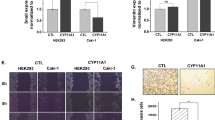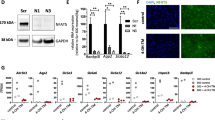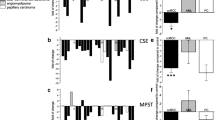Abstract
Renal cell carcinoma (RCC) remains one of the greatest challenges of urological oncology and is the third leading cause of death in genitourinary cancers. Surgery may be curative when patients present with localized disease. Our previous results demonstrated the autofluorescence of blood PpIX in primary RCC mouse model and an increase in fluorescence intensity as a function of growth of the subcutaneous tumor mass. In another work, a nice correlation between the growth of the tumor mass and tissue fluorescence intensity was found. The aim of this study was to evaluate the expression profile of porphyrin biosynthesis pathway-related genes of human kidney cells. We used two kidney cell lines, one normal (HK2) and another malignant (Caki-1). Endogenous and 5-aminolevolinic acid (ALA) induced protoporphyrin IX (PpIX) HK2 and Caki-1 cells were analyzed by fluorescence spectroscopy. Real-time quantitative polymerase chain reaction (qRT-PCR) was used to measure mRNA of those genes. Emission spectra were obtained by exciting the samples at 405 nm. For ALA untreated cells the maximum fluorescence intensity was detected at 635 nm. The mean peak area of emission spectra in both cells types increased linearly in function of cell number. Besides, basal levels of PpIX autofluorescence of each cell concentration of HK2 samples were significantly lower than those of Caki-1 samples. For ALA-treated cells the mean PpIX spectra shows PpIX emission peak at 635 nm with a shoulder at 700 nm. Analysis of PpIX fluorescence intensity ratio between tumor cells and HK2 cells showed that fluorescence intensity was, on average, 26 times greater in tumor cells than in healthy cells. qRT-PCR revealed that in Caki-1 ALA-treated cells, PEPT gene was significantly up-regulated and FECH and HO-1 genes were significantly down regulated in comparison with HK2 ALA-treated cells. In conclusion, our results demonstrate the preferential accumulation of ALA-induced PpIX in human RCC and also indicate that PEPT1, FECH and HO-1 genes are major contributors to this accumulation.




Similar content being viewed by others
References
Jorge A, Garcia MD, Brian I, Rini MD (2007) Recent progress in the management of advanced renal cell carcinoma. CA Cancer J Clin 57:112–125
Morais C, Johnson DW, Vesey DA, Gobe GC (2013) Functional significance of erythropoietin in renal cell carcinoma. BMC Cancer 13:14
Hollingsworth JM, Miller DC, Daignault S, Hollenbeck BK (2007) Five-year survival after surgical treatment for kidney cancer: a population–based competing risk analysis. Cancer 109:1763–1768
Assouad J, Petcova B, Berna P, Dujon A, Foucault C, Riquet M (2007) Renal cell carcinoma metastases surgery: pathologic findings and prognostic factors. Ann Thorac Surg 84(4):1114–1120
Schantz SP, Savage HE, Sacks P, Alfano RR (1997) Native cellular fluorescence and its application to cancer prevention. Environ Health Perspect 105(4):941
Ramanujam N (2000) Fluorescence spectroscopy of neoplastic and non-neoplastic tissues. Neoplasia 2(1–2):89–117
Chang KS, Ina P, Marin N, Follen M, Richards-Kortum R (2005) Fluorescence spectroscopy as a diagnostic tool for detecting cervical pre-cancer. Gynecol Oncol 99:S61–S63
Courrol LC, Silva FRO, Coutinho EL, Piccoli MF, Mansano RD, Vieira ND, Schor N, Bellini MH (2007) Study of blood porphyrin spectral profile for diagnosis of tumor progression. J Fluoresc 17(3):289–292
Bellini MH, Coutinho EL, Courrol LC, Silva FRO, Vieira ND, Schor N (2008) Correlation between autofluorescence intensity and tumor area in mice bearing renal cell carcinoma. J Fluoresc 18(6):1163–1168
Kusunoki Y, Imamura F, Uda H, Mano M, Horai T (2000) Early detection of lung cancer with laser-induced fluorescence endoscopy and spectrofluorometry. Chest 118:1776–1782
Tsai TM, Hong RL, Tsai JC (2004) Effect of 5-aminolevulinic acid-mediated photodynamic therapy on MCF-7 and MCF-7/ADR cells. Lasers Surg Med 34:64–72
Heyerdahl H, Wang I, Liu DL, Berg R, Andersson-Engels S, Peng Q, Moan J, Svanberg S, Svanberg K (1997) Pharmacokinetic studies on 5-aminolevulinic acid-induced protoporphyrin IX, accumulation in tumors and normal tissues. Cancer Lett 112:225–231
Van Der Breggen EWJ, Rem AI, Cristian MM, Yang CJ, Calhoun KH, Sterenborg HJCM, Motamedi M (1996) Spectroscopic detection of oral and skin tissue transformation in a model for squamous cell carcinoma: autofluorescence versus systemic aminolevulinic acid-induced fluorescence. IEEE J Sel Top Quantum Electron 2:997–1007
Moesta KT, Ebert B, Handke T, Nolte D, Nowak C, Haensch WE, Pandey RK, Dougherty TJ, Rinneberg H, Schlag PM (2001) Protoporphyrin IX occurs naturally in colorectal cancers and their metastases. Cancer Res 61:991–999
Tsuji T, Sasaki Y, Tanaka M, Hanabata N, Hada R, Munakata A (2002) Microvessel morphology and vascular endothelial growth factor expression in human colonic carcinoma with or without metastasis. Lab Investig 82:555–562
Otake M, Nishiwaki M, Kobayashi Y, Baba S, Kohno E, Kawasaki T, Fujise Y, Nakamur H (2003) Selective accumulation of ALA-induced PpIX and photodynamic effect in chemically induced hepatocellular carcinoma. Br J Cancer 89:730–736
Bourré L, Giuntini F, Eggleston IM, Wilson M, MacRobert AJ (2008) 5-Aminolaevulinic acid peptide prodrugs enhance photosensitization for photodynamic therapy. Mol Cancer Ther 7:1720–1729
Rocha FGG, Chaves KCB, Gomes CZ, Campanharo CB, Courrol LC, Schor N, Bellini MH (2010) Erythrocyte protoporphyrin fluorescence as a biomarker for monitoring antiangiogenic cancer therapy. J Fluoresc 20:1225–1231
Chakrabarti P, Orihuela E, Egger N, Neal DE Jr, Gangula R, Adesokun A, Motamedi M (1998) Delta-aminolevulinic acid-mediated photosensitization of prostate cell lines: implication for photodynamic. Ther Prostate Cancer Prostate 36:211–218
Croce AC, Santamaria G, De Simone U, Lucchini F, Freitas I, Bottiroli G (2011) Naturally-occurring porphyrins in a spontaneous-tumour bearing mouse model. Photochem Photobiol Sci 10:1189–1195
Millon SR, Ostrander JH, Yazdanfar S, Brown JQ, Bender JE, Rajeha A, Ramanujam N (2010) Preferential accumulation of 5-aminolevulinic acid-induced protoporphyrin IX in breast cancer: a comprehensive study on six breast cell lines with varying phenotypes. J Biomed Opt 15:018002- 1–018002- 8
Smits T, Robles CA, van EP EJ, van de Kerkhof PCM, Gerritsen MJ P (2005) Correlation between macroscopic fluorescence and protoporphyrin IX content in psoriasis and actinic keratosis following application of aminolevulinic acid. J Investig Dermatol 125:833–839
Silva FRO, Bellini MH, Nabeshima CT, Schor N, Vieira ND Jr, Courrol LC (2011) Enhancement of blood porphyrin emission intensity with aminolevulinic acid administration: a new concept for photodynamic diagnosis of early prostate cancer. Photodiagnosis Photodynamic Ther 8:7–13
Bigler J, Rand HA, Kerkof K, Timour M, Russell CB (2013) Cross-study homogeneity of psoriasis gene expression in skin across a large expression range. PLoS ONE 8:e52242
Nakanishi T (2007) Drug transporters as targets for cancer chemotherapy. Cancer Genomics Proteomics 4:241–254
Hagiya Y, Fukuhara H, Matsumoto K, Endo Y, Nakajima M, Tanaka T, Okura I, Kurabayashi A, Furihata M, Inoue K, Shuin T, Ogura S (2013) Expression levels of PEPT1 and ABCG2 play key roles in 5-aminolevulinic acid (ALA)-induced tumor-specific protoporphyrin IX (PpIX) accumulation in bladder cancer. Photodiagnosis Photodynamic Ther 10:288–295
Kemmner W, Wan K, Rüttinger S, Ebert B, Macdonald R, Klamm U, Moesta KT (2008) Silencing of human ferrochelatase causes abundant protoporphyrin-IX accumulation in colon câncer. FASEB J 22:500–509
Nowis D, Legat M, Grzela T, Niderla J, Wilczek E, Wilczynski GM, Glodkowska EG, Mrowka P, Issat T, Dulak J, Jozkowicz A, Was H, Adamek M, Wrzosek A, Nazarewski S, Makowski M, Stokosa T, Jako bisiak M, Goab J (2006) Heme oxygenase-1 protects tumor cells against photodynamic therapy-mediated cytotoxicity. Oncogene 25:3365–3374
Acknowledgments
This study was supported by FAPESP (Process number: 2010/52180-4) and CNPq (Process number: 134303/2013-0)
Author information
Authors and Affiliations
Corresponding author
Rights and permissions
About this article
Cite this article
da Rocha Filho, H.N., da Silva, E.C., Silva, F.R.O. et al. Expression of Genes Involved in Porphyrin Biosynthesis Pathway in the Human Renal Cell Carcinoma. J Fluoresc 25, 1363–1369 (2015). https://doi.org/10.1007/s10895-015-1626-x
Received:
Accepted:
Published:
Issue Date:
DOI: https://doi.org/10.1007/s10895-015-1626-x




